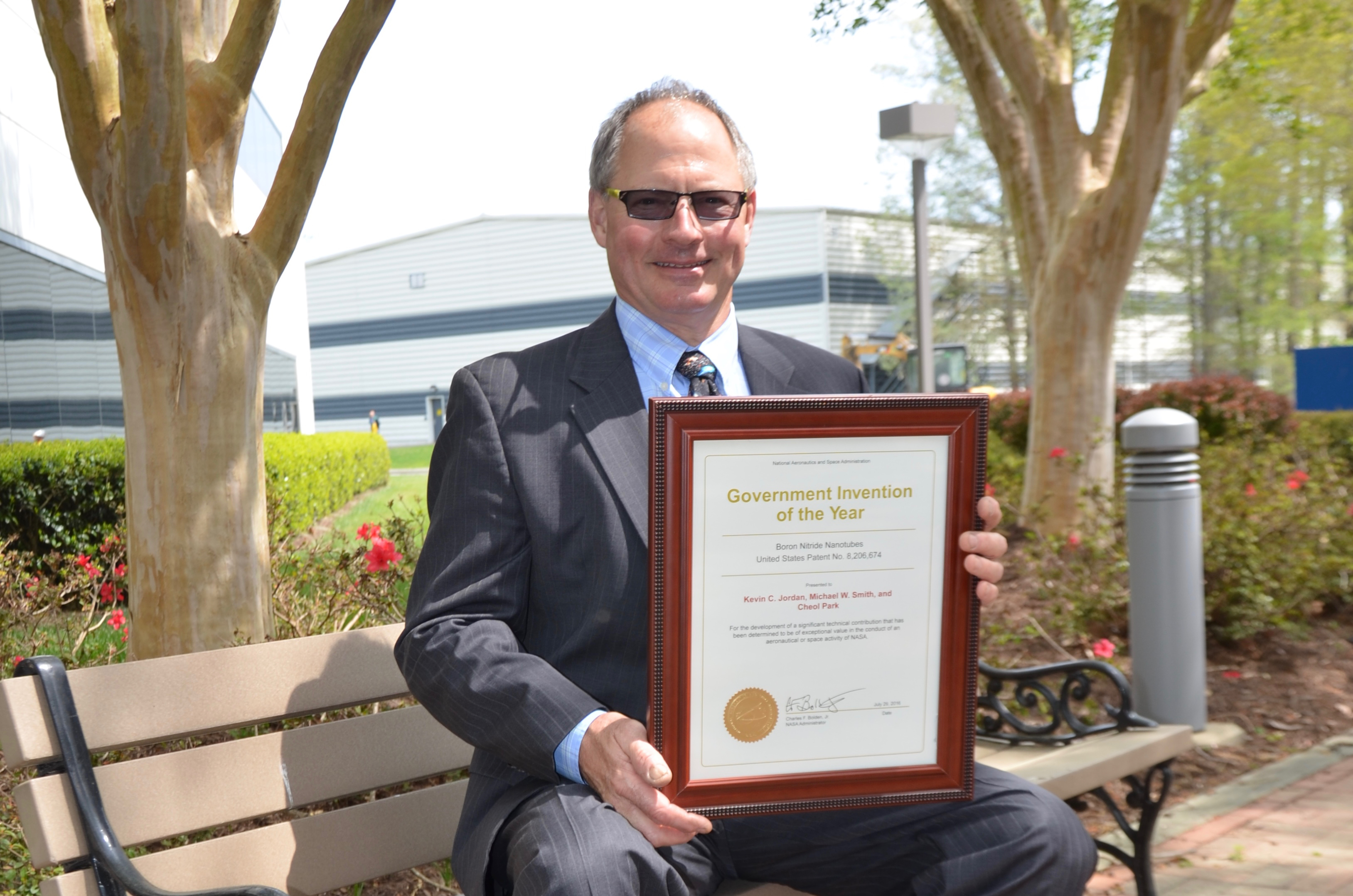Kevin Jordan, a staff engineer in Jefferson Lab’s Center for the Advanced Studies of Accelerators, was honored along with two of his colleagues earlier this year when he was presented with the 2016 NASA Invention of the Year award.
Of Kevin Jordan’s 21 patents, more than half come from his work on boron-nitride nanotubes. Earlier this year, Jordan and his colleagues were recognized for their efforts by the National Aeronautics and Space Administration when it named BNNTs as its 2016 NASA Government Invention of the Year.
“It’s an honor. Our work was chosen over the work of thousands of people at NASA,” Jordan said.
The award comes just as the Jefferson Lab staff engineer prepares to celebrate three decades of work at Jefferson Lab. He first came to the lab as a technician working on the Continuous Electron Beam Accelerator Facility in 1987. After earning a bachelor’s degree in electrical engineering in 1991, he later began working on the Free-Electron Laser, which is now called the Low Energy Recirculator Facility.
It was there that he learned about nanotubes. A nanotube is a molecule shaped like a really long soda straw that is about the size of a strand of DNA. Jordan first worked with a collaboration of Jefferson Lab, NASA and William & Mary researchers to produce carbon nanotubes. The collaboration received several patents for breakthroughs in the production of carbon nanotubes.
Through that work, he and his colleagues also learned of the possibilities of other nanotube materials, including BNNTs. BNNTs were first synthesized in small amounts in 1994 by researchers at DOE’s Lawrence Berkeley National Lab and the University of California, Berkeley. In 2009, using the LERF and a commercial welding laser, Jordan and his colleagues Mike Smith and Cheol Park at NASA's Langley Research Center and the National Institute of Aerospace conceived, pioneered and perfected a new technique to synthesize BNNTs, called the pressurized vapor/condenser (PVC) method.
The technique produced BNNTs that are lightweight, stable and exhibit high strength. Additionally, the BNNTs produced from this process are of sufficient quality, length and quantity that they could be twisted into yarn. Development of the technology was supported in part by the Department of Energy, the Office of Naval Research, NASA and the Commonwealth of Virginia.
BNNTs hold promise for a variety of uses, from heat sinks enabling next-generation computing to temperature-tolerant vibrational dampeners.
“We’re trying to develop a vibration damper that can work at cryogenic temperatures near absolute zero on up to temperatures over 800 degrees Celsius, and BNNTs have that potential,” he explained.
In 2013, Jordan and his fellow researchers formed a company that licensed the technology to scale up production of the novel material and explore its full potential.
“We don’t want to be just a materials supplier, we want to be an integral part of the supply chain of intellectual property,” Jordan said. “We’ve filed countless patents on technologies for application synthesis.”
Of the 19 U.S. Patent and Trademark Office patents that bear Kevin Jordan’s name, 11 of them refer to his work on boron-nitride nanotubes.
Jordan is now chief engineer at BNNT, LLC, a position he holds concurrently as a staff engineer in Jefferson Lab’s Center for the Advanced Studies of Accelerators. He said that he enjoys his dual roles and the challenges they bring.
“It hasn’t been an easy road. And yet, we’ve persevered,” Jordan said. “It’s a startup, so there’s no guarantee of success. But we’re putting in the hard work and passion. When you love what you do, it’s exciting to go to work every day.”
Contact: Kandice Carter, Jefferson Lab Communications Office, 757-269-7263, kcarter@jlab.org.
Further Reading:


